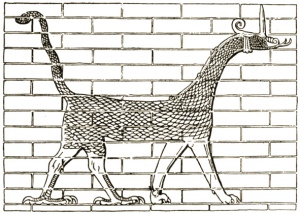
Sacred Texts Legendary Creatures
Buy this Book at Amazon.com
Buy this Book on Kindle


The Dragon on Ishtar's Gate |
The Evolution of the Dragonby G. Elliot Smith[1919] |
This is a set of three connected essays on the symbolism and development of the concept of the dragon in world mythology. The author, Grafton Elliot Smith (b. 1871, d. 1937), was Australian by birth, and an anatomist by profession. Smith wrote this while a Professor of Anatomy in Manchester, doing ground-breaking work on the evolution of the primate brain. He also treated veterans of WWI and did some of the earliest work on 'shell-shock,' today known as post-traumatic stress disorder.
His views on the origin of culture have not fared as well. Smith was a diffusionist, a school of thought popular in the late 19th and early 20th century which attempted to trace diverse cultural phenomena to unitary geographic points of origin. One example of this is Donnelly's Atlantis, which Donnelly proposed was the mother of all cultures. Smith, a bit more mainstream, traced the development of megalithic culture to Egypt, radiating out to distant lands, including America. Today, we know that megalithic culture preceded ancient Egyptian civilization, in some places by millennia, and developed independently in widely spaced geographic locations.
In this book, a compilation of three lecture series which he delivered shortly after WWI, Smith proposed a theory of how the dragon originated as a representation of the Mother Goddess, a symbol of the power and mystery of nature, and later evolved into a symbol of evil, turning into the prototype for the Christian devil. He uses linguistic, ethnographic, and biological data to bolster his theory. While in some respects a difficult book, depending on one's attention span, it is also a browser's delight. We learn about the origin of clothing, the water of immortality which Gilgamesh sought, and the symbolism, folklore and biology of the octopus, mandrake, pearls, cowry shells, etc. In particular, students of comparative mythology will enjoy this book, even if they reject Smith's hyperdiffusionist views.
Advertisements